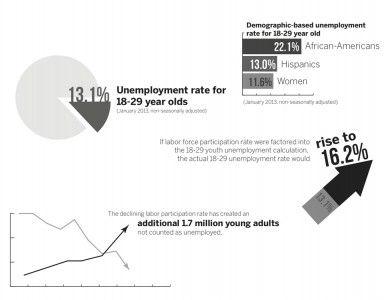
Despite its reported increase in youth unemployment in January, the January 2013 Millennial Jobs report released by Generation Opportunity fails to take seasonal employment fluctuations into account, Boston University officials said.
“Employment goes down in January because temporary employees begin to leave jobs. The same happens when students go on summer break and begin looking for jobs,” said Kevin Lang, a BU economics professor. “Whenever we look at an increase or decrease in employment, you have to adjust it seasonally.”
The January non-seasonally adjusted unemployment rate for young people — defined as people between the ages of 18 and 29 — was 13.1 percent, almost two percent higher than December’s rate, according to the report released Friday.
“[December’s] unemployment rate for people between the ages of 18 and 29 was 11.5 percent,” said Terence Grado, the Director of National and State Policy at Generation Opportunity. “Today, 18 to 29 youth unemployment is 13.1 percent.”
Grado said the numbers do not account for 1.7 million young adults who are no longer in the labor force, as these people have given up looking for work entirely because the of the economy’s poor state.
“The U.S. Department of Labor only considers people in the labor force that have looked for work in the last four weeks,” Grado said. “When you take that additional 1.7 million, with the 13.1 percent effective, you get an unemployment number at 16.2 percent.”
January unemployment for women in the age group was 11.6 percent, unemployment for Hispanics was 13 percent and unemployment for African Americans was 22.1 percent, according to the report.
Lang said the Bureau of Labor Statistics released a survey Friday that shows percentages small samples of unemployed people rising and falling every month.
“If you look at men 20 to 24 years old, we’re seeing a big jump in the last two months because we’re looking at a smaller and smaller sample,” he said. “You can see it is just a sampling error because you get the opposite story with 16-to-19-year-old men.”
Lang said these normal, monthly fluctuations should not raise alarm, despite the poor job market.
He said people between the ages of 18 and 29 compose a small sample when considering the size of the American workforce.
“There are times when unemployment demands grow, such as during the holiday season for seasonal jobs” Lang said. “Even if the economy is working consistently at the same level, there is going to be more unemployment in some periods and then less in certain months.”
A number of students said they believe there are other stimuli contributing to the increase in unemployment the report does not properly account for.
Victor Kholod, a College of Arts and Sciences freshman, said he thinks the report does not look at all the factors contributing to January unemployment.
“People have seasonal employees they know they can employ just over the holiday season,” Kholod said. “The report should take into account the migration to and from college towns and how that alone affects unemployment statistics.”
Alejandro Rivera, a fourth-year Graduate School of Arts and Sciences student, said it is necessary to adjust the data for people entering the labor force strictly seasonally for holiday breaks and summer breaks.
“Young people do not have benefits like people who have been in the labor force for a lot longer,” Rivera said. “More people are also willing to take jobs with lower wages, so there are plenty of people willing to work now.”
Jacopo Bizzotto, a GRS fifth-year student, also said the data should take into account normal fluctuations of unemployment.
“People look for jobs when their prospects are better,” Bizzotto said. “Also, people are not laid off before the holiday season out of respect, which is why unemployment grows after the holidays.”
CORRECTION: The article originally reported the January seasonally unadjusted unemployment rate increased. However, the proper term is non-seasonally adjusted. The article has been updated to reflect this correction.






















































































































Parley Elvina • Feb 5, 2013 at 10:22 pm
Keep up the wonderful work , I read few articles on this website and I think that your site is real interesting and has got circles of great info .